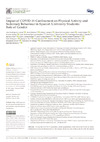Identificador persistente para citar o vincular este elemento:
https://accedacris.ulpgc.es/jspui/handle/10553/77488
| Título: | Impact of COVID-19 Confinement on Physical Activity and Sedentary Behaviour in Spanish University Students: Role of Gender | Autores/as: | Rodríguez-Larrad, Ana Mañas, Asier Labayen, Idoia González-Gross, Marcela Espin, Ander Aznar, Susana Serrano Sánchez, José Antonio Vera-Garcia, Francisco J. González-Lamuño, Domingo Ara, Ignacio Carrasco-Páez, Luis Castro-Piñero, José Gómez-Cabrera, Mari Carmen Márquez, Sara Tur, Josep A. Gusi, Narcis Benito, Pedro J. Moliner-Urdiales, Diego Ruiz, Jonatan R. Ortega, Francisco B. Jiménez-Pavón, David Casajús, José Antonio Irazusta, Jon |
Palabras clave: | International Physical Activity Questionnaire Lockdown Pandemic Physical Exercise |
Fecha de publicación: | 2021 | Publicación seriada: | International Journal of Environmental Research and Public Health | Resumen: | During the COVID-19 pandemic, entire populations were instructed to live in home-confinement to prevent the expansion of the disease. Spain was one of the countries with the strictest conditions, as outdoor physical activity was banned for nearly two months. This study aimed to analyse the changes in physical activity and sedentary behaviours in Spanish university students before and during the confinement by COVID-19 with special focus on gender. We also analysed enjoyment, the tools used and motivation and impediments for doing physical activity. An online questionnaire, which included the International Physical Activity Questionnaire Short Form and certain "ad hoc" questions, was designed. Students were recruited by distributing an invitation through the administrative channels of 16 universities and a total of 13,754 valid surveys were collected. Overall, university students reduced moderate (-29.5%) and vigorous (-18.3%) physical activity during the confinement and increased sedentary time (+52.7%). However, they spent more time on high intensity interval training (HIIT) (+18.2%) and mind-body activities (e.g., yoga) (+80.0%). Adaptation to the confinement, in terms of physical activity, was handled better by women than by men. These results will help design strategies for each gender to promote physical activity and reduce sedentary behaviour during confinement periods. | URI: | https://accedacris.ulpgc.es/handle/10553/77488 | DOI: | 10.3390/ijerph18020369 | Fuente: | International journal of environmental research and public health[EISSN 1660-4601],v. 18 (2), (Enero 2021) |
| Colección: | Artículos |
Citas SCOPUSTM
116
actualizado el 08-jun-2025
Citas de WEB OF SCIENCETM
Citations
102
actualizado el 08-jun-2025
Visitas
104
actualizado el 02-sep-2023
Descargas
62
actualizado el 02-sep-2023
Google ScholarTM
Verifica
Altmetric
Comparte
Exporta metadatos
Los elementos en ULPGC accedaCRIS están protegidos por derechos de autor con todos los derechos reservados, a menos que se indique lo contrario.
